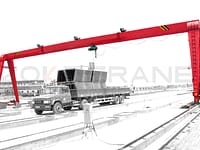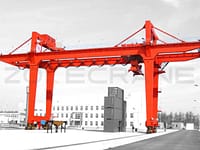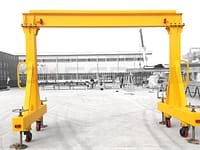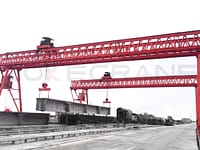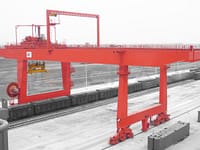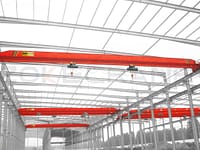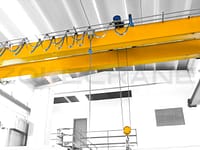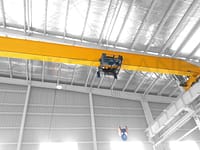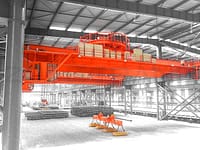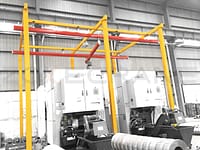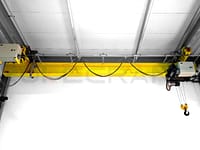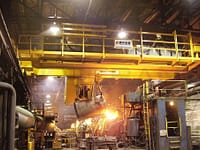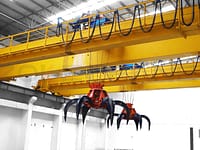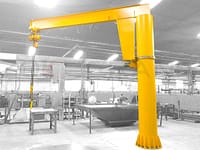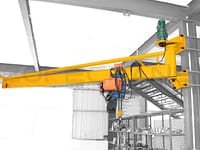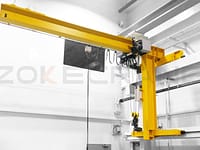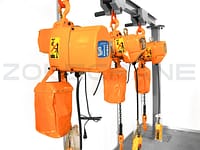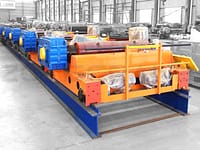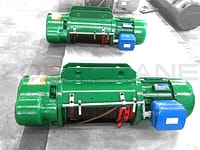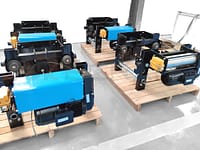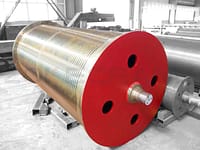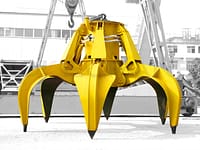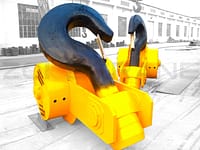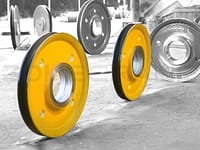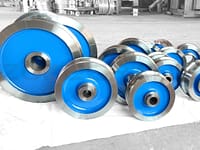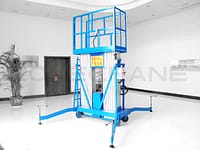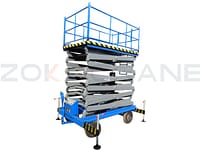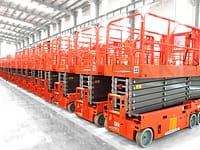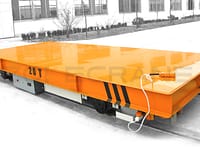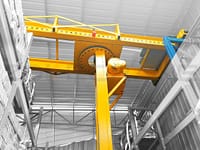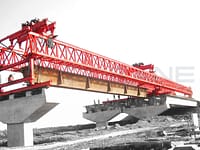The jib crane is a boom-type crane in which the retrieval device is hung on the end of the boom or on a lifting trolley that can run along the jib. The jib can be swivelled but cannot be pitched. It is a necessary separate emergency hoisting equipment for high-efficiency automatic production lines. It is mainly composed of a column, a swing arm, a swing arm drive device and an electric hoist. The bottom base of the column is fixed by anchor bolts on a concrete foundation. The motor drives the reducer drive device to make the cantilever rotate. The electric hoist makes a round trip on the cantilever I-beam. Run operations to make work efficient and energy-saving.
Jib crane is a small and medium-sized lifting equipment developed in recent years. It has unique structure, safety and reliability, high efficiency, energy saving, time saving, and flexibility. It can be operated at will within three-dimensional space. Other conventional lifting equipment shows its superiority.
Application and Structure of Jib Crane
Jib crane is a medium and small lifting and transportation equipment with a lifting weight of 0-5T. There are several types of mechanical transmission, hydraulic transmission and pneumatic. At present, the most widely used is mechanical transmission. Mechanical cranes usually use a screw pair drive device to drive the hoisted objects up and down through a four-link boom.
According to the structure, jib cranes include floor column jib cranes and wall jib cranes. The jib crane has the advantages of novel and simple structure, convenient operation and use, flexible rotation, and large working space. It is an energy-saving and efficient material lifting equipment. It can be widely used in the production line of the workshop, the assembly line, the upper and lower workpieces of the machine tool, and the lifting of heavy objects in warehouses and docks. This machine is composed of a column, a rotary cantilever and an electric chain hoist. The lower end of the column is fixed on the concrete floor, and the cantilever can be rotated according to user needs. The rotation part is divided into manual rotation and electric rotation (installation of cycloid pinwheel reducer to cooperate with the upper support plate or the lower support plate to drive the cantilever rotation of the rotating tube).
Research Progress of Jib Cranes
With the further deepening of economic construction, the volume of commodity circulation has increased substantially, and the rapid development of the transportation industry, the demand for lifting and transportation machinery is increasing, and the requirements for its use performance are also getting higher and higher.
China's crane industry was born in the 1970s. After more than 50 years of development, it has experienced three major technological improvements, including the introduction of Soviet technology in the 1970s, the introduction of Japanese technology in the early 1980s, and the introduction of German technology in the early 1990s. It has always been an independent innovation. path of.
Since 2000, with the increasing frequency of domestic and foreign technical exchanges and the significant enhancement of domestic independent research and development capabilities, more advanced foreign technologies have been successfully introduced and applied, such as crane electro-hydraulic proportional control technology, elliptical cross-section boom design and manufacturing technology , Multi-boom single-cylinder bolt telescoping technology, all-terrain crane oil-gas suspension and multi-mode multi-bridge steering technology have carried out independent innovations, obtained independent intellectual property rights, and applied them to a series of self-developed large-tonnage wheeled crane products. With the overall improvement of the manufacturing level of the domestic crane industry and the continuous narrowing of the gap with foreign advanced technology, Chinese crane products have begun to show obvious competitiveness in the international market. Jib crane equipment belongs to general machinery. In the process of rapid development for more than 20 years, it has gradually realized scale, group and mechanization. It is widely accepted by the machinery industry in auxiliary processing and production, and can play a role in realizing the continuity and automation of various processing procedures, greatly improving labor production efficiency and reducing labor intensity. It has the advantages of stable and reliable work, simple operation and maintenance, and convenience.
Development Prospects of Jib Cranes
According to the current situation, the machinery industry is on an upward trend, and the automobile industry and the motor vehicle industry are both in a period of strong development. Experts predict that with the growth of the economy, the machinery industry has been in a period of vigorous development for a long time. The use of jib cranes is in an irreplaceable and indispensable position in the overall machinery industry and in the future development process, and plays a role in the overall industrialization process. An important role in auxiliary production. The jib crane has the following characteristics: within the scope of its working space, under the premise of being able to move freely, it can keep the weight itself in a static balance in any space. This in itself forms a vast market and countless customer groups.
Jib crans equipment is very suitable for frequent lifting and transportation of workpieces weighing about one ton. The design structure is simple, the operation is flexible, and it is especially suitable for two-person operation, one-person control, one-person installation, intuitive feeling, high efficiency, convenient manufacturing and maintenance, and cantilever cranes are recognized and popularized in group and large-scale production. Welcome to production line workers. It is widely used in the loading and unloading of machine tools in the factory workshop, the lifting of workpieces between various processes, the production line, the assembly of parts and the lifting operations in workshop docks, warehouses and other occasions, effectively reducing the labor intensity of workers. It is a simple and practical new equipment that cannot be replaced by electric hoists and crane cranes in the workshop. In the field of mechanical processing, cantilever cranes have a strong buying market and broad development prospects.
Direction of Development
With the rapid development of modern computer control technology, the design of the jib crane has a higher level of requirements in comprehensive consideration of the safety and reliability of the control system, the comfort of operation, and the generalized optimization of the mechanism and structure. The development direction of the innovative design of the jib crane is the complete machine design with integrated parts, simple structure, and fully optimized structure; personalized design to meet the special requirements of individual users; new technical features that meet the requirements of market diversity and low cost The modular design of the new series of crane products; the maintenance-free design and maintenance-free design based on the life cycle of the product; the realization of the virtual design and dynamic simulation of a large single complex product. Innovative design in the true sense is the organic combination and comprehensive utilization of the above-mentioned design methods and technologies.
